Moment's Notice
Recent CDs Briefly Reviewed
(continued)
Max Eastley + Graham Halliwell + Evan Parker + Mark Wastell
a life saved by a spider and two doves
Another Timbre at06
Evan Parker Transatlantic Art Ensemble
Boustrophedon
ECM B0010988-02
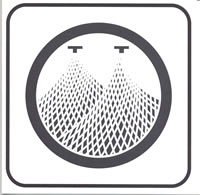 These two CDs may be as unlike one another as CDs by the same artist, almost simultaneously issued, might be – different in methodology, the notion of the musical line, harmonic concordance, etc. – yet each has a certain affinity with Parker’s work in his Electro-Acoustic Ensemble. One CD features “written” and otherwise structured materials for a 15-member ensemble playing conventional acoustic instruments; the other features an improvising quartet that includes an instrument constructed and played by a sound-sculptor, a computer and the miscellany of “metal percussion.” One changes constantly in substantial ways that are readily described, while the other changes incrementally in a distinctly sonic way that’s comparatively language-resistant. I suspect that because of those factors – coupled with issues of the name recognition of Parker’s partners and the relative promotional resources of ECM and Another Timbre – Boustrophedon may get far more attention than a life saved by a spider and two doves. And that would be a shame, for the almost secretive (I had to go to Google to find out what an arc is and what it looks like) a life saved… is a work of great beauty.
These two CDs may be as unlike one another as CDs by the same artist, almost simultaneously issued, might be – different in methodology, the notion of the musical line, harmonic concordance, etc. – yet each has a certain affinity with Parker’s work in his Electro-Acoustic Ensemble. One CD features “written” and otherwise structured materials for a 15-member ensemble playing conventional acoustic instruments; the other features an improvising quartet that includes an instrument constructed and played by a sound-sculptor, a computer and the miscellany of “metal percussion.” One changes constantly in substantial ways that are readily described, while the other changes incrementally in a distinctly sonic way that’s comparatively language-resistant. I suspect that because of those factors – coupled with issues of the name recognition of Parker’s partners and the relative promotional resources of ECM and Another Timbre – Boustrophedon may get far more attention than a life saved by a spider and two doves. And that would be a shame, for the almost secretive (I had to go to Google to find out what an arc is and what it looks like) a life saved… is a work of great beauty.
Boustrophedon comes from the same Transatlantic Art Ensemble that performed Roscoe Mitchell’s Composition/Improvisation Nos. 1, 2 & 3 released in 2007. A 14-member group composed of Mitchell’s Sound Ensemble and most of the acoustic players from the Electro-Acoustic Ensemble, the group includes clarinetist alto saxophonist Anders Svanoe, clarinetist John Rangecroft, flutist Neil Metcalfe, trumpeter Corey Wilkes, pianist Craig Taborn, a string section of violinist Phil Wachsmann, violist Nils Bultmann, and cellist Marcio Mattos, as well as two bassists, Jaribu Shahid and Barry Guy, and two percussionists, Tani Tabbal and Paul Lytton. The title means, literally, “ox-plowing” and it refers to an early form of Greek writing in which the writer, reaching the end of a line, turned down and headed, upside-down, in the opposite direction. Each of the work’s six “furrows” is in part written, in part improvised. But it’s not the sort of vague contour writing that improvisers often assign in large groups. It’s real writing, highly detailed in the manner of classical composition and the jazz big band. It’s also a blend of harmonic systems, wide voiced chords, atonality and folk scales. It’s rich in atmosphere and contrasts, from the evanescent combination of flute and strings (reminiscent of composers from Debussy to Boulez) that marks the opening of “Furrow 1” to the dense, surging horns that both underscore and challenge altoist Svanoe on “Furrow 3” as he constructs an extended solo that goes from song-like to coruscating. It’s a work in which written detail, formal contour and individual contributions have equal roles and the richness of texture depends not just on the writing but the quality of individual voices. Among them, Taborn plays an essential role, beautifully and authoritatively articulating materials in an essential connective role, while Mitchell supplies a riveting alto solo on ‘Furrow 6.” Parker’s methodological range is apparent in the way he constructs frameworks that seem as well suited to the Apollonian clarinet of Rangecroft as the sputtering, whinnying plunger work of Wilkes, both somehow at home in “Furrow 4.” The Parker saxophone emerges in a singular, haunting modal solo at the beginning of ‘Furrow 6.”
A life saved… documents the first meeting of the Eastley/Halliwell/Parker/ Wastell quartet in September 2007, but the group has continued to perform since the recording. Eastley is a sound sculptor and instrument builder who here plays an arc, an “electro acoustic monochord” of his own devising in the rich tradition of Harry Partch and Eddie “One String” Jones. It’s a nine-foot long, wooden, single-string instrument that changes pitch with a flexing of the wood. It’s also bowed and played with glass rods and its sound is altered electronically. Graham Halliwell, who has previously concentrated his energies on saxophone feedback, here plays computer and electronics, while Mark Wastell plays tam- tam, metal percussion and harmonium. Parker plays soprano exclusively. As all that might suggest, there’s a lot of droning going on, and the most characteristic sound is wisps of high-pitched soprano saxophone against the slow, harmonium-like oscillations of the other instruments. Even Wastell’s percussion is sometimes used for sustained sound, a deeply resonant gong shimmering through the electronics. The occasional glittering flash of struck percussion emphasizes the heightened resonance of the church in which it was recorded, but with the further suggestion of Japanese percussion employed in a Buddhist service, an inevitable analogy in a CD with artwork and titles derived from traditional works of Japan. Within its almost constant state, the music is always changing, sounds shifting and mutating. There’s no easy way to describe it, index perhaps of one of its values. The music is both stimulus and companion to reverie.
-Stuart Broomer
Frode Gjerstad Trio
Nothing is Forever
Circulasione Totale 10
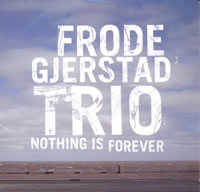 I have always found the idea that the Nordic climate and landscape should “naturally” produce the kind of music, or rather of sound, proposed by ECM with great success, coherence and imagination to be rather simplistic. In fact, there have always been all Nordic musicians that developed in the same cultural context, but developed their music along very different lines. Examples range from Finland’s Edward Vesala to Denmark’s Pierre Dørge. One of their more significant contemporaries is Norwegian clarinetist and saxophone player Frode Gjerstad, who first came to notoriety with another reeds/bass/drums trio: Detail, with John Stevens on drums and Johnny Dyani on bass. With them, Gjerstad created very energetic music, where the occasional groove could find space; but whose main thrust was the research of an open dialogue between the musicians where each gesture has meaning and relevance. For this, Gjerstad openly prefers small ensembles up to the quartet, even if his orchestra Circulasione Totale (another name like “I Compani” that is very hard for an Italian to swallow) with electric guitars and even rappers has been a successful attempt to apply improvisatory processes in a large ensemble. Apart from Circulasione Totale, Gjerstad’s ensembles have always included non-Norwegian musicians, including a trio with William Parker and Hamid Drake, as well as a duo with Peter Brotzmann. About ten years ago, Gjerstad created his first all-Norwegian trio with Øyvind Storesund on bass and Paal Nilssen-Love on drums; this was apparently satisfactory because this is their seventh release, counting CDs where the trio collaborated with guest musicians.
I have always found the idea that the Nordic climate and landscape should “naturally” produce the kind of music, or rather of sound, proposed by ECM with great success, coherence and imagination to be rather simplistic. In fact, there have always been all Nordic musicians that developed in the same cultural context, but developed their music along very different lines. Examples range from Finland’s Edward Vesala to Denmark’s Pierre Dørge. One of their more significant contemporaries is Norwegian clarinetist and saxophone player Frode Gjerstad, who first came to notoriety with another reeds/bass/drums trio: Detail, with John Stevens on drums and Johnny Dyani on bass. With them, Gjerstad created very energetic music, where the occasional groove could find space; but whose main thrust was the research of an open dialogue between the musicians where each gesture has meaning and relevance. For this, Gjerstad openly prefers small ensembles up to the quartet, even if his orchestra Circulasione Totale (another name like “I Compani” that is very hard for an Italian to swallow) with electric guitars and even rappers has been a successful attempt to apply improvisatory processes in a large ensemble. Apart from Circulasione Totale, Gjerstad’s ensembles have always included non-Norwegian musicians, including a trio with William Parker and Hamid Drake, as well as a duo with Peter Brotzmann. About ten years ago, Gjerstad created his first all-Norwegian trio with Øyvind Storesund on bass and Paal Nilssen-Love on drums; this was apparently satisfactory because this is their seventh release, counting CDs where the trio collaborated with guest musicians.
In terms of lightspeed communication between the players, the most obvious parallel is Evan Parker's trio with Barry Guy and Paul Lytton; but the individual personalities of Gjerstad’s trio are very different, so that the sound of the group is also completely different: Gjerstad's masterful control of instrumental overtones and multiphonic blowing meets with a dark, soft and often relaxed playing from bass and drums. The four longish tracks move across a wide range of atmospheres. Conceptually, they are quite similar to other recordings by Gjerstad, with the group entering into loose grooves when so inclined, and leaving ample space for solos and duo episodes. Nilssen-Love is as always a very exciting and flexible player, it's a pleasure to hear him react to small, detailed sounds or immediately find the right level of energy to accompany the small fragments of melody played by Gjerstad; Storesund usually seems to feel comfortable providing background, but he can engage in lively duets exchanging high notes with the reeds or rhythmic figures with the drums. The trio freely accumulates sonic materials until a pattern emerges and the music then takes off from there, always holding the listener's attention in the process; the music very rarely becomes rises to all-out blowing, keeping the energy flowing through control and careful listening instead. Gjerstad’s phrasing employs wide intervals and a chirping, bird-like sound, and makes a very convincing case for an original and highly original combination of Eric Dolphy's and Albert Ayler's lineages. The different strategies devised by drums and bass in reaction to the unexpected breaks, jumps and timbral microvariations in the reeds' lines make for this listener the most exciting moments in a very successful CD.
-Francesco Martinelli
Malcolm Goldstein
a sounding of sources
New World 806767-2
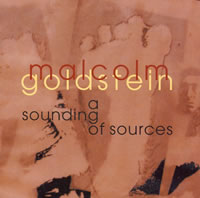 There is an elegant programmatic symmetry to Malcolm Goldstein’s a sounding of sources, which collects two contrasting readings of the violinist’s “Configurations in Darkness” and his two “Ishi” pieces. By beginning and ending with solo performances, Goldstein circumscribes a vast expanse of conceptual territory with his singular strength as a violinist, cohering what would otherwise be a mixed lot of tracks. In doing so, Goldstein reinforces the idea that sequencing an album has a compositional tip.
There is an elegant programmatic symmetry to Malcolm Goldstein’s a sounding of sources, which collects two contrasting readings of the violinist’s “Configurations in Darkness” and his two “Ishi” pieces. By beginning and ending with solo performances, Goldstein circumscribes a vast expanse of conceptual territory with his singular strength as a violinist, cohering what would otherwise be a mixed lot of tracks. In doing so, Goldstein reinforces the idea that sequencing an album has a compositional tip.
It takes hearing Goldstein’s opening solo version of “Configurations in Darkness” and the quintet version back to back to fully realize the reading-to-reading structural flexibility of Goldstein’s pieces, particularly in how source materials can be accessed; in this case, Bela Bartók’s transcriptions of several folksongs from Bosnia-Herzogovina. Whereas Goldstein takes the regional practice of ornamentation to a bristling, textured extreme in the solo version, his cohorts in the quintet version – trombonist Radu Malfatti, clarinetist-saxophonist Philippe Micol, flutist Philippe Racine, and cellist Beat Schneider – spend much of the performance fastidiously building layers of laconic textures and quavering long tones that eventually elongate into dovetailing slithers of melody. Of Goldstein’s collaborators, Schneider makes the most overt use of the source materials, and then only somewhat sparingly. Though Malfatti’s playing is well outside the idiom of the source materials, he does work a few well-honed phrases with a lyrical touch, an approach that has been all but airbrushed out of his improvising in the 13 years since both versions of the piece were recorded.
Something of a reverse relationship is established by having Goldstein’s solo “Ishi/ ‘man waxati’ Soundings” follow “Ishi/timechangingspaces,” an “Acoustic Art/Radio Work,” two 1988 works that share an involved back story. Ishi had the tragic distinction of being the last member of the Yahi tribe, which had retreated into the Bay Area woodlands and remained unknown until he made contact in 1911. Becoming something of a ward of the University of California, Berkeley’s anthropology department, Ishi made wax cylinder recordings of 40 Yahi songs and recorded two discourses on earthquakes, nature and travel. Goldstein constructed “timechangingspaces” from these recordings, deconstructing what must have been expressions of the core of Yahi culture and spirituality into layers of empathic, jabbing rhythms and stark, spectral textures. The scratches on the cylinders render as a rhythmic counterpoint to the compelling intensity of Ishi’s voice. Heard out of context, “timechangesspaces” is an engaging piece; when its source materials are considered, it is chilling. Goldberg retunes his violin on ‘man waxati,’ approximating the abrasive relationship between pitch and timbre on the cylinders, the epicenter of the music’s sonic power.
-Bill Shoemaker
Grosse Abfahrt
Everything that disappears
Emanem 4146
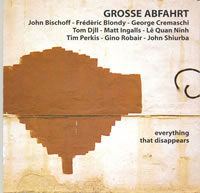 Grosse Abfahrt (German for “great departure”) is a free improvisation ensemble launched by trumpeter Tom Djll to combine a group of Bay Area musicians with visitors, usually European. Here the Bay-area musicians include guitarist John Shiurba, bassist George Cremaschi, clarinetist Matt Ingalls, and Gino Robair (on “energised surfaces & voltage made audible” which I take to mean electronically altered percussion). The ensemble also includes Tim Perkis and John Bischoff, whose pioneering work in computer-based improvised music was recently celebrated on the New World collection, The League of Automatic Music Composers. The guests are French, the percussionist Lê Quan Ninh and pianist Frédèric Blondy. Each is a master of resonance, Ninh working on an assortment of cymbals and drums on top of a large horizontal bass drum, Blondy -- perhaps best known for his work with the quintet Hubbub – concentrating on the piano’s interior with a range of techniques that includes bowing the strings. It is that focus on resonance that often defines this work, including an idea of circular, oscillating sound (the very movement of bowing) that seems concentrated at times in Cremaschi’s bass and his particular use of electronics.
Grosse Abfahrt (German for “great departure”) is a free improvisation ensemble launched by trumpeter Tom Djll to combine a group of Bay Area musicians with visitors, usually European. Here the Bay-area musicians include guitarist John Shiurba, bassist George Cremaschi, clarinetist Matt Ingalls, and Gino Robair (on “energised surfaces & voltage made audible” which I take to mean electronically altered percussion). The ensemble also includes Tim Perkis and John Bischoff, whose pioneering work in computer-based improvised music was recently celebrated on the New World collection, The League of Automatic Music Composers. The guests are French, the percussionist Lê Quan Ninh and pianist Frédèric Blondy. Each is a master of resonance, Ninh working on an assortment of cymbals and drums on top of a large horizontal bass drum, Blondy -- perhaps best known for his work with the quintet Hubbub – concentrating on the piano’s interior with a range of techniques that includes bowing the strings. It is that focus on resonance that often defines this work, including an idea of circular, oscillating sound (the very movement of bowing) that seems concentrated at times in Cremaschi’s bass and his particular use of electronics.
The group’s focus is on extended improvisation, long unwindings of sound in which instrumental identities submerge into collective mind. Even the track titles – vertical readings from Jean Baudrillard’s America – hint at new relationships in which sudden coherence may be as much the result of chance as intention and in which the fragmentary or discontinuous is equally valued. Thus, the longest track, “geometric undulating driveway symmetrical, all the road of masters.” Is, at nearly 39 minutes, a world unto itself, populated with radio beeping, somber bowed bass and bass clarinet tones and a host of sounds that may defy ready identification. Everything appears hyper-resonant, from prepared trumpet to a sudden electric squiggle. While there’s an underlying continuum of sound for long stretches, and individual gestures might sound deliberated, this is by no means minimalist. Near the half-hour mark, there’s a sudden episode of skittering trumpet and bass that emphasizes the underlying unpredictability before the piece ends with a period of sustained high frequencies. Its ultimate shape, though, is always secondary to its immediate being, its sense of collective process.
The other tracks have their own distinctive qualities, at times reflecting a dominance of acoustic or electronic sound. “[N]egativity paradox achieved in humor realm” is a relatively rambunctious piece that – without Shiurba, Bischoff and Perkis – is virtually acoustic. “Admittedly, social relations This,” with substantial electronics, seems more abrasive and, at times, much closer to conventions of improvised dialogue. Throughout, though, this is valuable work, with its own distinctive concordances and frictions.
-Stuart Broomer
Maurice Horsthuis’ Jargon
Elastic Jargon
DATA 071
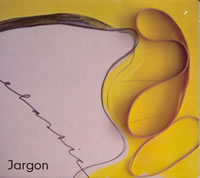 Dutch violist-composer Horsthuis has crafted a post-modern gem of an album for his 11-piece string ensemble, Jargon. The music is, in the composer’s words, “elastic, not eclectic,” and it’s an important distinction. The compositions’ common technical vocabulary, its musical jargon, draws from a couple hundred years’ worth of European classical music, tango, and American idioms such as jazz and blues. But the music doesn’t jump among styles; it fuses them into one language. Bits and pieces might recall one period, style, or individual composer, but there’s always another component undermining a direct resemblance. At its best, the music confounds any attempt to reduce it to any single identifiable source. “Op Kauwgom” patches together a Bartokian theme with Baroque underpinnings and Classical flourishes tinged with occasional blues inflections. This elusive stylistic quality also characterizes the incongruous merging of Reich, Mozart, Stravinsky, and electric guitar outbursts heard in “BoxRing.” “La Philo” sounds like a Burt Bacharach melody supported by Mahler. It sounds as if most of the music is written out, but there is some improvisation and Horsthuis also delights in blurring or even erasing the distinction between the two. Like Misha Mengelberg, Horsthuis loves puns (verbal and musical). The title “Op Kauwgom” or “On Chewing Gum,” plays on the elastic nature of the candy and its use as an improvised adhesive—an apt, if homely, metaphor for Elastic Jargon. Behind all the playfulness lies Horsthuis’ subtle intelligence and genuine affection for strong melody, rich orchestration, and lively performance. Horsthuis and Jargon never resort to outright parody or ironic distancing from its sources; they embrace them and sing in their chains like the sea.
Dutch violist-composer Horsthuis has crafted a post-modern gem of an album for his 11-piece string ensemble, Jargon. The music is, in the composer’s words, “elastic, not eclectic,” and it’s an important distinction. The compositions’ common technical vocabulary, its musical jargon, draws from a couple hundred years’ worth of European classical music, tango, and American idioms such as jazz and blues. But the music doesn’t jump among styles; it fuses them into one language. Bits and pieces might recall one period, style, or individual composer, but there’s always another component undermining a direct resemblance. At its best, the music confounds any attempt to reduce it to any single identifiable source. “Op Kauwgom” patches together a Bartokian theme with Baroque underpinnings and Classical flourishes tinged with occasional blues inflections. This elusive stylistic quality also characterizes the incongruous merging of Reich, Mozart, Stravinsky, and electric guitar outbursts heard in “BoxRing.” “La Philo” sounds like a Burt Bacharach melody supported by Mahler. It sounds as if most of the music is written out, but there is some improvisation and Horsthuis also delights in blurring or even erasing the distinction between the two. Like Misha Mengelberg, Horsthuis loves puns (verbal and musical). The title “Op Kauwgom” or “On Chewing Gum,” plays on the elastic nature of the candy and its use as an improvised adhesive—an apt, if homely, metaphor for Elastic Jargon. Behind all the playfulness lies Horsthuis’ subtle intelligence and genuine affection for strong melody, rich orchestration, and lively performance. Horsthuis and Jargon never resort to outright parody or ironic distancing from its sources; they embrace them and sing in their chains like the sea.
-Ed Hazell
